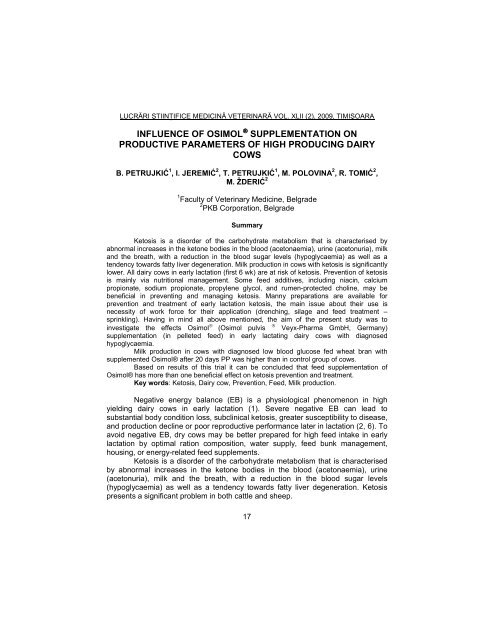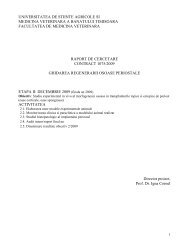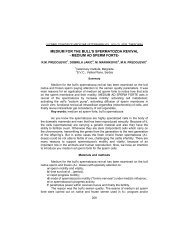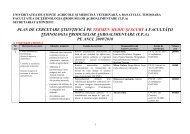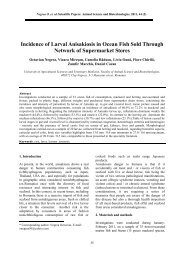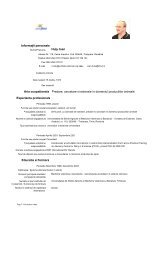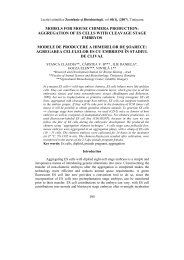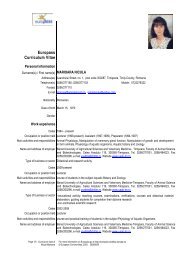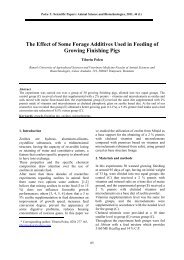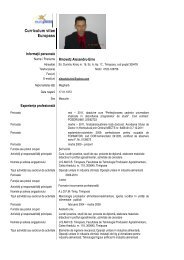influence of osimol® supplementation on productive parameters of ...
influence of osimol® supplementation on productive parameters of ...
influence of osimol® supplementation on productive parameters of ...
You also want an ePaper? Increase the reach of your titles
YUMPU automatically turns print PDFs into web optimized ePapers that Google loves.
LUCRĂRI ŞTIINłIFICE MEDICINĂ VETERINARĂ VOL. XLII (2), 2009, TIMIŞOARA<br />
INFLUENCE OF OSIMOL ® SUPPLEMENTATION ON<br />
PRODUCTIVE PARAMETERS OF HIGH PRODUCING DAIRY<br />
COWS<br />
B. PETRUJKIĆ 1 , I. JEREMIĆ 2 , T. PETRUJKIĆ 1 , M. POLOVINA 2 , R. TOMIĆ 2 ,<br />
M. ŽDERIĆ 2<br />
1 Faculty <str<strong>on</strong>g>of</str<strong>on</strong>g> Veterinary Medicine, Belgrade<br />
2 PKB Corporati<strong>on</strong>, Belgrade<br />
Summary<br />
Ketosis is a disorder <str<strong>on</strong>g>of</str<strong>on</strong>g> the carbohydrate metabolism that is characterised by<br />
abnormal increases in the ket<strong>on</strong>e bodies in the blood (acet<strong>on</strong>aemia), urine (acet<strong>on</strong>uria), milk<br />
and the breath, with a reducti<strong>on</strong> in the blood sugar levels (hypoglycaemia) as well as a<br />
tendency towards fatty liver degenerati<strong>on</strong>. Milk producti<strong>on</strong> in cows with ketosis is significantly<br />
lower. All dairy cows in early lactati<strong>on</strong> (first 6 wk) are at risk <str<strong>on</strong>g>of</str<strong>on</strong>g> ketosis. Preventi<strong>on</strong> <str<strong>on</strong>g>of</str<strong>on</strong>g> ketosis<br />
is mainly via nutriti<strong>on</strong>al management. Some feed additives, including niacin, calcium<br />
propi<strong>on</strong>ate, sodium propi<strong>on</strong>ate, propylene glycol, and rumen-protected choline, may be<br />
beneficial in preventing and managing ketosis. Manny preparati<strong>on</strong>s are available for<br />
preventi<strong>on</strong> and treatment <str<strong>on</strong>g>of</str<strong>on</strong>g> early lactati<strong>on</strong> ketosis, the main issue about their use is<br />
necessity <str<strong>on</strong>g>of</str<strong>on</strong>g> work force for their applicati<strong>on</strong> (drenching, silage and feed treatment –<br />
sprinkling). Having in mind all above menti<strong>on</strong>ed, the aim <str<strong>on</strong>g>of</str<strong>on</strong>g> the present study was to<br />
investigate the effects Osimol ® (Osimol pulvis ® Veyx-Pharma GmbH, Germany)<br />
<str<strong>on</strong>g>supplementati<strong>on</strong></str<strong>on</strong>g> (in pelleted feed) in early lactating dairy cows with diagnosed<br />
hypoglycaemia.<br />
Milk producti<strong>on</strong> in cows with diagnosed low blood glucose fed wheat bran with<br />
supplemented Osimol® after 20 days PP was higher than in c<strong>on</strong>trol group <str<strong>on</strong>g>of</str<strong>on</strong>g> cows.<br />
Based <strong>on</strong> results <str<strong>on</strong>g>of</str<strong>on</strong>g> this trial it can be c<strong>on</strong>cluded that feed <str<strong>on</strong>g>supplementati<strong>on</strong></str<strong>on</strong>g> <str<strong>on</strong>g>of</str<strong>on</strong>g><br />
Osimol® has more than <strong>on</strong>e beneficial effect <strong>on</strong> ketosis preventi<strong>on</strong> and treatment.<br />
Key words: Ketosis, Dairy cow, Preventi<strong>on</strong>, Feed, Milk producti<strong>on</strong>.<br />
Negative energy balance (EB) is a physiological phenomen<strong>on</strong> in high<br />
yielding dairy cows in early lactati<strong>on</strong> (1). Severe negative EB can lead to<br />
substantial body c<strong>on</strong>diti<strong>on</strong> loss, subclinical ketosis, greater susceptibility to disease,<br />
and producti<strong>on</strong> decline or poor re<strong>productive</strong> performance later in lactati<strong>on</strong> (2, 6). To<br />
avoid negative EB, dry cows may be better prepared for high feed intake in early<br />
lactati<strong>on</strong> by optimal rati<strong>on</strong> compositi<strong>on</strong>, water supply, feed bunk management,<br />
housing, or energy-related feed supplements.<br />
Ketosis is a disorder <str<strong>on</strong>g>of</str<strong>on</strong>g> the carbohydrate metabolism that is characterised<br />
by abnormal increases in the ket<strong>on</strong>e bodies in the blood (acet<strong>on</strong>aemia), urine<br />
(acet<strong>on</strong>uria), milk and the breath, with a reducti<strong>on</strong> in the blood sugar levels<br />
(hypoglycaemia) as well as a tendency towards fatty liver degenerati<strong>on</strong>. Ketosis<br />
presents a significant problem in both cattle and sheep.<br />
17
LUCRĂRI ŞTIINłIFICE MEDICINĂ VETERINARĂ VOL. XLII (2), 2009, TIMIŞOARA<br />
All dairy cows in early lactati<strong>on</strong> (first 6 wk) are at risk <str<strong>on</strong>g>of</str<strong>on</strong>g> ketosis. The<br />
incidence in lactati<strong>on</strong> is estimated at 5-16%, but incidence in individual herds varies<br />
substantially. Ketosis occurs in all parities (although it appears to be less comm<strong>on</strong><br />
in primiparous animals) and does not appear to have a genetic predispositi<strong>on</strong>,<br />
other than being associated with dairy breeds. Cows with excessive adipose stores<br />
(body c<strong>on</strong>diti<strong>on</strong> score ≥3.75 out <str<strong>on</strong>g>of</str<strong>on</strong>g> 5.0) at calving are at increased risk <str<strong>on</strong>g>of</str<strong>on</strong>g> ketosis,<br />
compared with those with lower body c<strong>on</strong>diti<strong>on</strong> scores. Lactating cows with<br />
hyperket<strong>on</strong>emia (subclinical ketosis—serum BHB c<strong>on</strong>centrati<strong>on</strong>s >12 mg/dL) are at<br />
increased risk <str<strong>on</strong>g>of</str<strong>on</strong>g> developing clinical ketosis, compared with cows with lower serum<br />
BHB c<strong>on</strong>centrati<strong>on</strong>s (3).<br />
The resulting clinical symptoms affect above all the digestive system<br />
(lactati<strong>on</strong> indigesti<strong>on</strong>) and the central nervous system (principally a depressed<br />
state, sometimes with extreme agitati<strong>on</strong>). In individual cases a differentiati<strong>on</strong> can<br />
be made according to the primary symptoms between a digestive and a nervous<br />
form <str<strong>on</strong>g>of</str<strong>on</strong>g> acet<strong>on</strong>aemia. However, both have the same pathogenesis. Ketosis occurs<br />
either al<strong>on</strong>e or as a c<strong>on</strong>comitant complicati<strong>on</strong> al<strong>on</strong>gside other diseases (egg<br />
retained afterbirth, traumatic reticulitis).<br />
The pathogenesis <str<strong>on</strong>g>of</str<strong>on</strong>g> bovine ketosis is incompletely understood, but it<br />
requires the combinati<strong>on</strong> <str<strong>on</strong>g>of</str<strong>on</strong>g> intense adipose mobilizati<strong>on</strong> and a high glucose<br />
demand. Both <str<strong>on</strong>g>of</str<strong>on</strong>g> these c<strong>on</strong>diti<strong>on</strong>s are present in early lactati<strong>on</strong>, at which time<br />
negative energy balance leads to adipose mobilizati<strong>on</strong> and milk synthesis creates a<br />
high glucose demand. Adipose mobilizati<strong>on</strong> is accompanied by high blood serum<br />
c<strong>on</strong>centrati<strong>on</strong>s <str<strong>on</strong>g>of</str<strong>on</strong>g> n<strong>on</strong>esterified fatty acids (NEFA). During periods <str<strong>on</strong>g>of</str<strong>on</strong>g> intense<br />
gluc<strong>on</strong>eogenesis, a large porti<strong>on</strong> <str<strong>on</strong>g>of</str<strong>on</strong>g> serum NEFA is directed to ket<strong>on</strong>e body<br />
synthesis in the liver. Thus, the clinicopathologic characterizati<strong>on</strong> <str<strong>on</strong>g>of</str<strong>on</strong>g> ketosis<br />
includes high serum c<strong>on</strong>centrati<strong>on</strong>s <str<strong>on</strong>g>of</str<strong>on</strong>g> NEFA and ket<strong>on</strong>e bodies and low<br />
c<strong>on</strong>centrati<strong>on</strong>s <str<strong>on</strong>g>of</str<strong>on</strong>g> glucose. In c<strong>on</strong>trast to many other species, cattle with<br />
hyperket<strong>on</strong>emia do not have c<strong>on</strong>current acidemia. The serum ket<strong>on</strong>e bodies are<br />
acet<strong>on</strong>e, acetoacetate, and β-hydroxybutyrate (BHB).<br />
There is speculati<strong>on</strong> that the pathogenesis <str<strong>on</strong>g>of</str<strong>on</strong>g> ketosis cases occurring in the<br />
immediate postpartum period is slightly different than that <str<strong>on</strong>g>of</str<strong>on</strong>g> cases occurring closer<br />
to the time <str<strong>on</strong>g>of</str<strong>on</strong>g> peak milk producti<strong>on</strong>. Cases <str<strong>on</strong>g>of</str<strong>on</strong>g> ketosis in very early lactati<strong>on</strong> are<br />
usually associated with fatty liver. Both fatty liver and ketosis are probably part <str<strong>on</strong>g>of</str<strong>on</strong>g> a<br />
spectrum <str<strong>on</strong>g>of</str<strong>on</strong>g> c<strong>on</strong>diti<strong>on</strong>s associated with intense fat mobilizati<strong>on</strong> in cattle. Ketosis<br />
cases occurring closer to peak milk producti<strong>on</strong>, which usually occurs at 4-6 wk<br />
postpartum, may be more closely associated with underfed cattle experiencing a<br />
metabolic shortage <str<strong>on</strong>g>of</str<strong>on</strong>g> gluc<strong>on</strong>eogenic precursors than with excessive fat<br />
mobilizati<strong>on</strong>.<br />
The exact pathogenesis <str<strong>on</strong>g>of</str<strong>on</strong>g> the clinical signs is not known. They do not<br />
appear to be associated directly with serum c<strong>on</strong>centrati<strong>on</strong>s <str<strong>on</strong>g>of</str<strong>on</strong>g> either glucose or<br />
ket<strong>on</strong>e bodies. There is speculati<strong>on</strong> that they may be due to metabolites <str<strong>on</strong>g>of</str<strong>on</strong>g> the<br />
ket<strong>on</strong>e bodies (3).<br />
18
LUCRĂRI ŞTIINłIFICE MEDICINĂ VETERINARĂ VOL. XLII (2), 2009, TIMIŞOARA<br />
Preventi<strong>on</strong> <str<strong>on</strong>g>of</str<strong>on</strong>g> ketosis is mainly via nutriti<strong>on</strong>al management. Body c<strong>on</strong>diti<strong>on</strong><br />
should be managed in late lactati<strong>on</strong>, when cows frequently become too fat. The dry<br />
period is generally too late to reduce body c<strong>on</strong>diti<strong>on</strong> score. Reducing body<br />
c<strong>on</strong>diti<strong>on</strong> in the dry period may even be counter<strong>productive</strong>, resulting in excessive<br />
adipose mobilizati<strong>on</strong> prepartum. A critical area in ketosis preventi<strong>on</strong> is maintaining<br />
and promoting feed intake. Cows tend to reduce feed c<strong>on</strong>sumpti<strong>on</strong> in the last 3 wk<br />
<str<strong>on</strong>g>of</str<strong>on</strong>g> gestati<strong>on</strong>. Nutriti<strong>on</strong>al management should be aimed at minimizing this reducti<strong>on</strong>.<br />
C<strong>on</strong>troversy exists over the optimal dietary characteristics during this period. It is<br />
likely that optimal energy and fiber c<strong>on</strong>centrati<strong>on</strong>s in rati<strong>on</strong>s for cows in the last 3<br />
wk <str<strong>on</strong>g>of</str<strong>on</strong>g> gestati<strong>on</strong> vary from farm to farm. Feed intake should be m<strong>on</strong>itored and<br />
rati<strong>on</strong>s adjusted to maximize dry matter and energy c<strong>on</strong>sumpti<strong>on</strong> in late gestati<strong>on</strong>.<br />
After calving, diets should promote rapid and sustained increases in feed and<br />
energy c<strong>on</strong>sumpti<strong>on</strong>. Rati<strong>on</strong>s should be relatively high in n<strong>on</strong>fiber carbohydrate<br />
c<strong>on</strong>centrati<strong>on</strong>, but c<strong>on</strong>tain enough fiber to maintain rumen health and feed intake.<br />
Neutral-detergent fiber c<strong>on</strong>centrati<strong>on</strong>s should usually be in the range <str<strong>on</strong>g>of</str<strong>on</strong>g> 28-30%<br />
with n<strong>on</strong>fiber carbohydrate c<strong>on</strong>centrati<strong>on</strong>s in the range <str<strong>on</strong>g>of</str<strong>on</strong>g> 38-41%. Dietary particle<br />
size will <str<strong>on</strong>g>influence</str<strong>on</strong>g> the optimal proporti<strong>on</strong>s <str<strong>on</strong>g>of</str<strong>on</strong>g> carbohydrate fracti<strong>on</strong>s. Some feed<br />
additives, including niacin, calcium propi<strong>on</strong>ate, sodium propi<strong>on</strong>ate, propylene<br />
glycol, and rumen-protected choline, may be beneficial in preventing and managing<br />
ketosis. To be effective, these supplements should be fed in the last 2-3 wk <str<strong>on</strong>g>of</str<strong>on</strong>g><br />
gestati<strong>on</strong>, as well as during the period <str<strong>on</strong>g>of</str<strong>on</strong>g> ketosis susceptibility (3).<br />
Manny preparati<strong>on</strong>s are available for preventi<strong>on</strong> and treatment <str<strong>on</strong>g>of</str<strong>on</strong>g> early<br />
lactati<strong>on</strong> ketosis, the main issue about their use is necessity <str<strong>on</strong>g>of</str<strong>on</strong>g> work force for their<br />
applicati<strong>on</strong> (drenching, silage and feed treatment – sprinkling). Having in mind all<br />
above menti<strong>on</strong>ed, the aim <str<strong>on</strong>g>of</str<strong>on</strong>g> the present study was to investigate the effects<br />
Osimol ® (Osimol pulvis ® Veyx-Pharma GmbH, Germany) <str<strong>on</strong>g>supplementati<strong>on</strong></str<strong>on</strong>g> (in<br />
pelleted feed) in early lactating dairy cows with diagnosed hypoglycaemia.<br />
Producer recommends use <str<strong>on</strong>g>of</str<strong>on</strong>g> Osimol® for the prophylaxis and treatment <str<strong>on</strong>g>of</str<strong>on</strong>g> ketosis<br />
in both primary and sec<strong>on</strong>dary indigesti<strong>on</strong>s.<br />
Materials and methods<br />
At the beginning <str<strong>on</strong>g>of</str<strong>on</strong>g> the trial (three days post partum) in sample <str<strong>on</strong>g>of</str<strong>on</strong>g> 50 Holstein<br />
Friesian cows, age form 3 to 5 years, determined level <str<strong>on</strong>g>of</str<strong>on</strong>g> blood glucose in 14 cows<br />
was below physiological minimum (under 2.2 mmol/L), these cows were then given<br />
pelleted feed supplemented with Osimol and formed experimental group (group E)<br />
(n=14). C<strong>on</strong>trol group (group C) <str<strong>on</strong>g>of</str<strong>on</strong>g> cows c<strong>on</strong>sisted <str<strong>on</strong>g>of</str<strong>on</strong>g> 15 animals <str<strong>on</strong>g>of</str<strong>on</strong>g> the same breed<br />
and age in same phase <str<strong>on</strong>g>of</str<strong>on</strong>g> lactati<strong>on</strong> (early lactati<strong>on</strong>) but with physiological level <str<strong>on</strong>g>of</str<strong>on</strong>g><br />
glucose (over 2.2 mmol/L) (n=15). Blood samples for glucose determinati<strong>on</strong> were<br />
collected via coccigeal vein. Level <str<strong>on</strong>g>of</str<strong>on</strong>g> glucose in blood was measured in stable (<strong>on</strong><br />
site) just after collecti<strong>on</strong> using quick test Accu-Chek ® (Accu-Chek Blood Glucose<br />
Systems, Roche). Level <str<strong>on</strong>g>of</str<strong>on</strong>g> blood glucose was rechecked <strong>on</strong> day 20 post partum.<br />
19
LUCRĂRI ŞTIINłIFICE MEDICINĂ VETERINARĂ VOL. XLII (2), 2009, TIMIŞOARA<br />
All cows were fed by standard rati<strong>on</strong> which has met or exceeded the nutrient<br />
recommendati<strong>on</strong>s for lactating cows (4). Cows in experimental group (group E)<br />
were given pelleted wheat bran with supplemented Osimol ® in amount <str<strong>on</strong>g>of</str<strong>on</strong>g> 100<br />
g/cow/day. Osimol ® (Compositi<strong>on</strong>: Sodium bicarb<strong>on</strong>ate, glucose, trace element<br />
premix, additives. 1 kg c<strong>on</strong>tains: 500,000 mg calcium propi<strong>on</strong>ate, 345,000 mg<br />
sodium propi<strong>on</strong>ate, 1,380 mg manganese, 325 mg copper and 20 mg cobalt) was<br />
pelleted with wheat bran in ratio 100 g <str<strong>on</strong>g>of</str<strong>on</strong>g> Osimol to 900 grams <str<strong>on</strong>g>of</str<strong>on</strong>g> wheat bran. Cows<br />
<str<strong>on</strong>g>of</str<strong>on</strong>g> E group were fed Osimol® supplemented fed for 10 c<strong>on</strong>secutive days.<br />
Raw compositi<strong>on</strong> and calculated chemical compositi<strong>on</strong> <str<strong>on</strong>g>of</str<strong>on</strong>g> meal <str<strong>on</strong>g>of</str<strong>on</strong>g> both c<strong>on</strong>trol<br />
and experimental group <str<strong>on</strong>g>of</str<strong>on</strong>g> cows is given in table 1.<br />
Table 1<br />
Meal compositi<strong>on</strong><br />
Feed<br />
C<strong>on</strong>trol (kg/day)<br />
Group<br />
Experimental (kg/day)<br />
Lucerne hay 4 4<br />
Whole plant corn silage 22 22<br />
Extruded soybean meal 1.50 1.50<br />
C<strong>on</strong>centrate 8.5 8.5<br />
Pelleted wheat bran without Osimol 1 -<br />
Pelleted wheat bran with Osimol - 1<br />
Total 37.05 37.05<br />
Meal chemical compositi<strong>on</strong> calculative analysis<br />
DM. kg/day 19.37 19.37<br />
DM, % BM 3.13 3.13<br />
Crude protein, % DM 14.81 14.81<br />
Crude fiber (celluloses), % DM 17.63 17.63<br />
ADF, % 25.76 25.76<br />
NDF, % 43.05 43.05<br />
Crude fat, % DM 2.29 2.29<br />
Ca, % DM 0.67 0.67<br />
P, % DM 0.41 0.44<br />
Na, % DM 0.49 0.49<br />
Mg, % DM 0.17 0.23<br />
K, % DM 0.81 0.80<br />
S, % DM 0.21 0.21<br />
Results obtained in this study were compared by standard statistical<br />
methods and shown in graphs.<br />
20
LUCRĂRI ŞTIINłIFICE MEDICINĂ VETERINARĂ VOL. XLII (2), 2009, TIMIŞOARA<br />
Results and discussi<strong>on</strong>s<br />
Results <str<strong>on</strong>g>of</str<strong>on</strong>g> blood glycaemia <strong>on</strong> day 3 and day 20 post partum (PP) <str<strong>on</strong>g>of</str<strong>on</strong>g> cows<br />
in c<strong>on</strong>trol and experimental group are given in figure 1.<br />
Fig. 1.Values <str<strong>on</strong>g>of</str<strong>on</strong>g> blood glycaemia in c<strong>on</strong>trol and experimental group <str<strong>on</strong>g>of</str<strong>on</strong>g> cows.<br />
Average level <str<strong>on</strong>g>of</str<strong>on</strong>g> glucose in blood <str<strong>on</strong>g>of</str<strong>on</strong>g> c<strong>on</strong>trol group <strong>on</strong> day 3 PP was 2.52 ±<br />
0.288mmol/L and <strong>on</strong> day 20 PP 2.553 ± 0.180mmol/L. Determined level <str<strong>on</strong>g>of</str<strong>on</strong>g> blood<br />
glucose in c<strong>on</strong>trol group <str<strong>on</strong>g>of</str<strong>on</strong>g> cows did not significantly differ, that was not the case in<br />
experimental group where lowest value <str<strong>on</strong>g>of</str<strong>on</strong>g> blood glucose was determined <strong>on</strong> day 3<br />
PP. Blood glucose in experimental group <str<strong>on</strong>g>of</str<strong>on</strong>g> cows was <strong>on</strong> day 3 PP 1.843 ±<br />
0.265mmol/L and <strong>on</strong> day 20 PP 2.357±0.303mmol/L. This was statistically highly<br />
significant difference (p
LUCRĂRI ŞTIINłIFICE MEDICINĂ VETERINARĂ VOL. XLII (2), 2009, TIMIŞOARA<br />
By analysis <str<strong>on</strong>g>of</str<strong>on</strong>g> the data obtained in this trial it can be seen that lowest blood<br />
glycaemia which was determined in E group <str<strong>on</strong>g>of</str<strong>on</strong>g> cows <strong>on</strong> the beginning <str<strong>on</strong>g>of</str<strong>on</strong>g> the trial<br />
1.843 ± 0.265mmol/L did not significantly <str<strong>on</strong>g>influence</str<strong>on</strong>g> milk producti<strong>on</strong> in the same<br />
group. Nevertheless, producti<strong>on</strong> <str<strong>on</strong>g>of</str<strong>on</strong>g> milk <strong>on</strong> day 20 PP in E group <str<strong>on</strong>g>of</str<strong>on</strong>g> cows was<br />
higher (35.57 ± 3.589L/day) compared to c<strong>on</strong>trol group <str<strong>on</strong>g>of</str<strong>on</strong>g> cows (31.00 ± 6.392<br />
L/day).<br />
Scientific explanati<strong>on</strong> <str<strong>on</strong>g>of</str<strong>on</strong>g> these results can be in fact that with Osimol®,<br />
large quantities <str<strong>on</strong>g>of</str<strong>on</strong>g> propi<strong>on</strong>ic acid are supplied to the body through the calcium<br />
propi<strong>on</strong>ate and sodium propi<strong>on</strong>ate c<strong>on</strong>tained in the preparati<strong>on</strong>. After it has been<br />
absorbed, propri<strong>on</strong>ic acid is involved primarily in the extremely important formati<strong>on</strong><br />
<str<strong>on</strong>g>of</str<strong>on</strong>g> glucose. With sodium propi<strong>on</strong>ate and calcium propi<strong>on</strong>ate, glucoplastic<br />
substances are therefore supplied to the body which have glucogenic and<br />
antiketogenic acti<strong>on</strong> when they are utilised. For their part, the ingredients c<strong>on</strong>tained<br />
in the product promote the activity <str<strong>on</strong>g>of</str<strong>on</strong>g> the microorganisms in the rumen and<br />
therefore have a positive effect <strong>on</strong> ruminal digesti<strong>on</strong>; they stimulate a whole range<br />
<str<strong>on</strong>g>of</str<strong>on</strong>g> metabolic processes which results in higher milk producti<strong>on</strong>.<br />
Results obtained in this study are in compliance with other authors who<br />
have studied same problem. Schultz (5) found that the oral administrati<strong>on</strong> <str<strong>on</strong>g>of</str<strong>on</strong>g> 1/2 lb.<br />
<str<strong>on</strong>g>of</str<strong>on</strong>g> sodium propi<strong>on</strong>ate daily for from three to ten days to cows with uncomplicated<br />
ketosis was effective. Same author has found that propi<strong>on</strong>ate-fed cows showed<br />
higher blood sugar levels, lower blood ket<strong>on</strong>e levels, and produced more milk for<br />
the first 6 wk. after calving than did the c<strong>on</strong>trol cows. This was the case and in our<br />
trial except <str<strong>on</strong>g>of</str<strong>on</strong>g> blood sugar level which was not higher than in c<strong>on</strong>trol group, this is<br />
probably due to high milk producti<strong>on</strong> which is much higher nowadays than it was in<br />
1953 when Schultz studied effects <str<strong>on</strong>g>of</str<strong>on</strong>g> sodium propi<strong>on</strong>ate.<br />
C<strong>on</strong>clusi<strong>on</strong>s<br />
Meal <str<strong>on</strong>g>supplementati<strong>on</strong></str<strong>on</strong>g> <str<strong>on</strong>g>of</str<strong>on</strong>g> 100g/cow/day <str<strong>on</strong>g>of</str<strong>on</strong>g> Osimol ® have improved level <str<strong>on</strong>g>of</str<strong>on</strong>g><br />
blood glucose in experimental group <str<strong>on</strong>g>of</str<strong>on</strong>g> cows which were diagnosed lower than<br />
minimal physiological level 3 rd day PP.<br />
Milk producti<strong>on</strong> in cows with diagnosed low blood glucose fed wheat bran<br />
with supplemented Osimol® after 20 days PP was higher than in c<strong>on</strong>trol group <str<strong>on</strong>g>of</str<strong>on</strong>g><br />
cows.<br />
Based <strong>on</strong> results <str<strong>on</strong>g>of</str<strong>on</strong>g> this trial it can be c<strong>on</strong>cluded that feed <str<strong>on</strong>g>supplementati<strong>on</strong></str<strong>on</strong>g><br />
<str<strong>on</strong>g>of</str<strong>on</strong>g> Osimol® has more than <strong>on</strong>e beneficial effect <strong>on</strong> ketosis preventi<strong>on</strong> and<br />
treatment and should be used at least three days pre partum and 7 days post<br />
partum as prescribed by producer. Effect <str<strong>on</strong>g>of</str<strong>on</strong>g> meal <str<strong>on</strong>g>supplementati<strong>on</strong></str<strong>on</strong>g> with Osimol® <strong>on</strong><br />
reproducti<strong>on</strong> needs to be investigated.<br />
22
LUCRĂRI ŞTIINłIFICE MEDICINĂ VETERINARĂ VOL. XLII (2), 2009, TIMIŞOARA<br />
References<br />
1. G<str<strong>on</strong>g>of</str<strong>on</strong>g>f, J.P., Horst R.L., Physiological changes at parturiti<strong>on</strong> and their<br />
relati<strong>on</strong>ship to metabolic disorders. J. Dairy Sci. 1997, 80, 1260–1268.<br />
2. Heuer, C., Schukken, Y.H., Dobbelaar, P., Postpartum body c<strong>on</strong>diti<strong>on</strong> score<br />
and results from the first test day milk as predictors <str<strong>on</strong>g>of</str<strong>on</strong>g> disease, fertility, yield,<br />
and culling in commercial dairy herds. J. Dairy Sci. 1999, 82, 295–304.<br />
3. Kahn, C.M. (Ed.), The Merck Veterinary Manual – ninth editi<strong>on</strong>. MERCK &<br />
CO., INC. WHITEHOUSE STATION, N.J., U.S.A.830-32, 2005.<br />
4. NRC, Nutrient requirements <str<strong>on</strong>g>of</str<strong>on</strong>g> Dairy Cattle. Seventh Revised Editi<strong>on</strong>, Nat.<br />
Acad. Press, Washingt<strong>on</strong>, DC, 2001.<br />
5. Schultz, L.G., Further Studies <strong>on</strong> the Use <str<strong>on</strong>g>of</str<strong>on</strong>g> Sodium Propi<strong>on</strong>ate in the<br />
C<strong>on</strong>trol <str<strong>on</strong>g>of</str<strong>on</strong>g> Ketosis in Dairy Cattle. J. Dairy Sci., 1953, 36, 597.<br />
6. Senatore, E.M.W., Butler, R., Oltenacu, P.A., Relati<strong>on</strong>ship between energy<br />
balance and post-partum ovarian activity and fertility in first lactati<strong>on</strong> dairy<br />
cows. Anim. Prod., 1996, 62, 17–23.<br />
23


